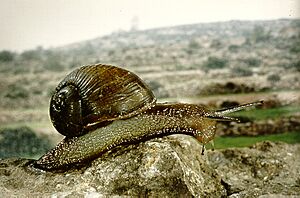Green garden snail facts for kids
Quick facts for kids Green garden snail |
|
|---|---|
 |
|
| Cantareus apertus | |
| Scientific classification | |
| Synonyms | |
|
The Cantareus apertus, often called the green garden snail, is a type of land snail that breathes air. It's a mollusc found on land and belongs to the Helicidae family, which includes many common snails.
Contents
Where the Green Garden Snail Lives
The green garden snail originally comes from Europe, especially near the Mediterranean Sea, and also North Africa.
You can find Cantareus apertus in these places:
- France, west of the Rhone river mouth. It is protected there and cannot be collected for selling.
- Islands in the Tyrrhenian Sea.
- Italy, from the Italian peninsula up to Liguria and Romagna.
- Ionian islands.
- Malta.
- Central Greece.
- Aegean Islands.
- Cyprus (only in one specific spot).
- Mediterranean parts of North Africa.
In some parts of Italy, like Salento, it's known as municeḍḍe. In Sicily, people call it attuppateḍḍu.
This snail has also traveled to other areas:
- It has settled in California and Louisiana in the United States.
- Western Australia – where it is not native.
Because it can spread easily, this snail is seen as a possible threat in the United States. It could become a pest that harms farms, natural areas, or businesses. Because of this, some people think it should be a top priority for quarantine in the USA.
What the Green Garden Snail Looks Like
The shell of the green garden snail has a special outer layer called a periostracum. This layer gives the shell its olive green color. The very last whorl (or coil) of the shell is much bigger than the others.
The shell is usually about 22 to 28 millimeters wide. It is also about 22 to 28 millimeters tall.
How the Green Garden Snail Lives
Cantareus apertus lives in Mediterranean shrublands. You can often find it near farms and gardens. In Gavdos, Greece, it also lives in woodlands that used to be farms. Sometimes, it can be found in natural areas too.
In Crete, these snails are active for about three to four months. This happens after the first rains in October. When the weather gets hot and dry, the snail burrows deep into the soil. It can go three to six inches underground. There, it becomes dormant, which is like a long sleep, until rain makes the soil soft again. To protect itself during this dormant period, it creates a white, dome-shaped cover called an epiphragm.
Reproduction of the Green Garden Snail
This type of snail is known for making and using special structures called love darts. These are used during mating.
Images for kids




